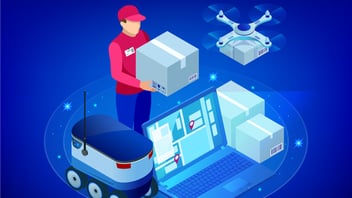Quickly reacting to new levels of supply chain risk essential to maintaining business operations
Continuity of supply is at the heart of supply chain management. Risks in the supply chain have the potential of interrupting the flow of goods and services, disrupting global operations. The impact on financial performance, customer operations, as well as other partners in the supply chain can be devastating. Companies need to continually assess supply chain risk and ensure that they have the necessary advanced planning tools and technologies in place to quickly react to changes in the supply chain, ensuring business continuity for themselves, their suppliers and their customers.
Risks in the supply chain can be global, such as political and civil unrest or border closures, environmental, such as a storm or other natural disaster, or domestic, such as a highway detour for construction or an accident. While these examples certainly have different levels of risk, all may impact scheduled deliveries, business operations and customer satisfaction. Sadly, the definition of risk has broadened and become more complex. Risk now includes supply chain security management, including acts of terrorism, product and information theft, endangered personnel and sabotage to critical infrastructure.
This year, there was a wave of devastating hurricanes and earthquakes that put supply chain risks on the front page. One example is the Hurricane Harvey, where oil refineries in the Houston area were shut down due to flooding, spiking gasoline prices across the United States and impacting global petroleum prices and related products.
Dr Edward Knab recently advised that most businesses are already experiencing major challenges in their supply chain resulting from the down turn in the global economy. Some key financial risks & ways companies are handling them are
Lack of working capital – Businesses are being forced to consider non -traditional sources of working capital. Companies are reducing inventory to free up operating cash, rationalize product lines to focus on profitable products and lower operating costs.
Economic Downturn risks –Has translated into major restructuring of supply chain operations in an attempt for businesses to survive & to better position themselves for additional market share and profits when the economy begins to recover.
Energy costs – Businesses must plan for variable energy and commodity prices, as well as variable labour and currency exchange rates.
Having transparency and visibility in the end-to-end supply chain is a solid step in identifying risks – be it operational or financial. As the supplier tiers expand, visibility decreases. A high performing local supplier may have a critical source of supply in a country with frequent disruptions in commerce or transport. Identifying all risk areas in a supply chain is almost impossible. Suppliers may also be unwilling to share information that may put their business relationship at risk with you, creating an information gap that is tough to close. Dr. David Simchi-Levi, MIT professor, author, and noted supply chain management expert tells us the ‘risk is hidden in unexpected places’.
Companies need to actively address business continuity planning (BCP) from a number of directions. Certainly, companies need to be able to react to an unexpected disruptive occurrence, be it a short-term transportation issue with a local trucking company or a break in supply due to an aforementioned natural disaster. A short-term issue may require a simple workaround. However, a larger and often unexpected problem requires a high degree of preparation and back up support, including materials, processes, systems and personnel. It is important to deploy these assets on a timely and controlled basis, managing costs, additional delays, and information throughout the affected partners. Concurrent issues may arise from companies in the supply chain who have not adequately planned for business continuity, creating exponential disruptions.
Those managing business continuity planning must address some important macro business issues. Working capital may be at risk, and there is evidence that companies are significantly increasing cash reserves to meet unexpected costs in overcoming severe operational disruptions, as well as potential long-term damage to the economy. Recovery from a major incident may be unpredictable and the ability to quickly react to global shifts in supply and demand patterns is critical. Disaster Recovery Plans (DRP), a subset of business continuity planning, has become more mainstream and comprehensive, aided by the adoption of technology across the global supply chain.
Researchers at Michigan State University studied the inbound logistics operations at different companies and developed a 4-step framework for logistics related business continuity. Step one is awareness, making sure that those in the supply chain were aware of potential disruptions and prepared to handle them. Step two is prevention, creating a risk profile, alternative transportation methods and monitoring for disruptions. Step three is remediation, or controlling the consequences of a disruption. This includes having a team in place to resolve problems. The last step is knowledge management, including debriefing on how a business interruptions situation was handled and how best to improve reactions to future issues.
Companies can gain competitive advantage, especially in operations and financial performance, by using business continuity planning in their logistics operations. Proactive planning, rather than reactive management, is important, and forward-looking companies are moving from a limited functional plan to one that is enterprise-wide. Comprehensive ERP solutions, like those available through Ramco Systems, can provide across the board applications that can address these critical business interruption and supply chain risk issues through proper planning and seamless execution.








